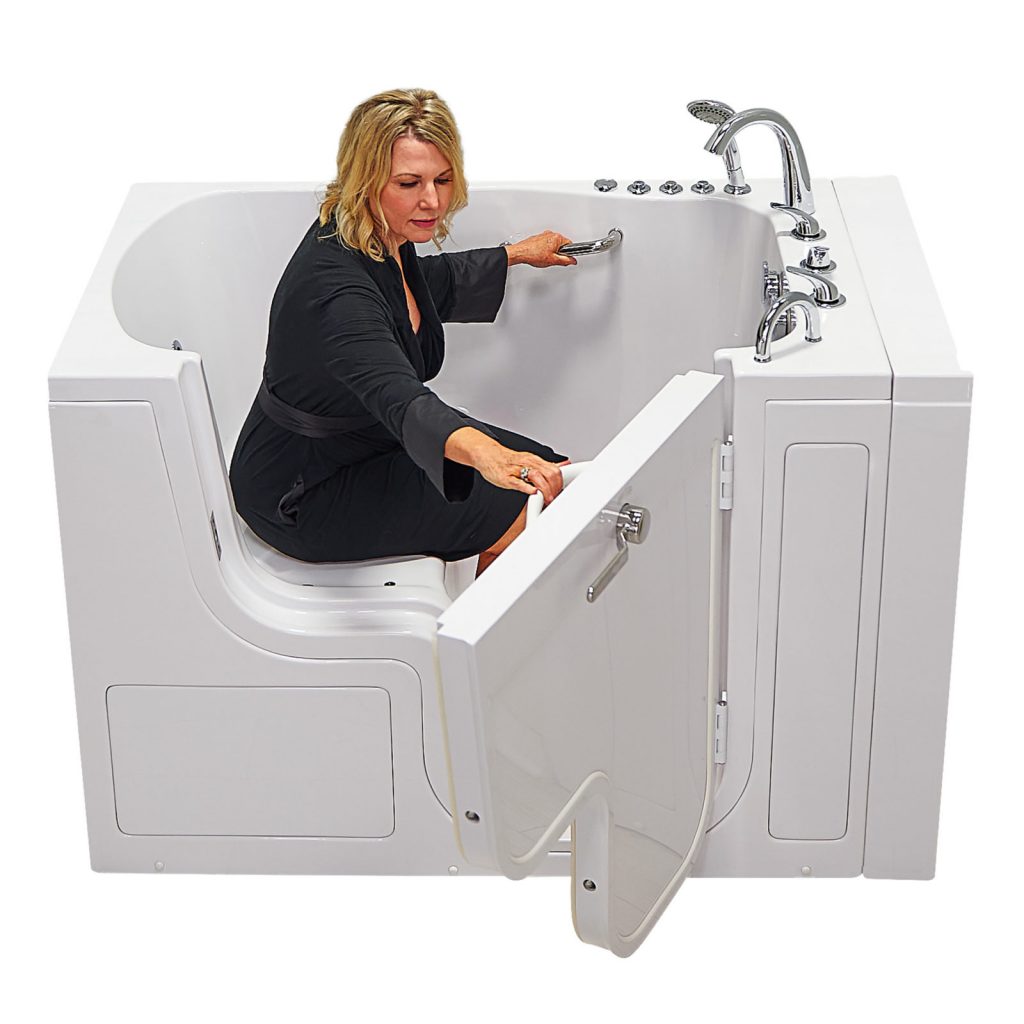The bariatric walk-in tub is designed specifically to meet unique bariatric special needs. It has a large door and seat that can hold over 300 pounds.
Like other household goods and living items designed for bariatric use, the tubs are more significant and sturdier than more traditional walk-in tubs.
This is a must-have for individuals with bariatric needs. The size of traditional walk-in tubs is too small for individuals with bariatric.
Individuals with bariatric needs often require proper seating, which a walk-in tub provides. However, the standard sizes sold by walk-in tub sellers are too small, and that’s where a bariatric walk-in tub comes in.
What makes them different from other Walk-in Tubs?
A bariatric walk-in tub can be 45% larger than traditional walk-in tubs.
Many tubs that call themselves bariatric are only a few inches wider at the seat. When looking for a bariatric walk-in tub, be sure to find a proper size.
Bariatric walk-in tubs have wider doors, a wider seat, and a sturdier frame. Many individuals with bariatric needs prefer walk-in tubs to regular tubs because of the convenience of bathing while seated. However, they can find bathing in regular tubs cumbersome or even painful.
What’s great about a Bariatric Walk-in Tub?
First, they provide proper room to relax. A tub is a place to get comfortable and relax. There’s little reason for the extra expense of a walk-in tub if you don’t plan on enjoying it. There are hundreds of models of bariatric walk-in tubs that offer a number of amenities, from aromatherapy to mood lighting to heated seats. All water and air jets come equipped in many bariatric walk-in tubs available. Melting away the aches and pains of the world in a frothy, hot tub is what these tubs are ultimately about.
Not only does the larger and sturdier tub offer more support to aid individuals with mobility issues, but several other safety features are available on bariatric walk-in tubs. Non-slip floors, grab bars, and the low signature entry steps make walk-in tubs a safer alternative to traditional tubs for many individuals.
Are there any special installation requirements?
There are some considerations with a bariatric walk-in tub. These tubs not only occupy more floor space than a regular tub, but they can weigh more. The weight of the tub and the weight of water in the tub can be factors to consider.
Second-story bathroom floors will be rated for a specific structural weight, and the bariatric tub could come close to meeting the load limit. The plumbing and electrical components of the tub will not require special consideration compared to traditional walk-in tubs.
Will the cost of a Bariatric Walk-in Tub be covered by Medicare or Medicaid?
In two words—unlikely, but maybe. Medicare covers medical equipment used in the home, specifically durable medical equipment. Because other family members can use a tub and it is not a direct form of treatment for an illness or injury, it is unlikely that Medicare will cover the cost. You can, however, try to get a written notice from a doctor demonstrating the necessity of the bariatric walk-in tub. With a doctor’s note, there’s a chance—still slim—that part of the expense could be reimbursed.
Medicaid may cover a portion or the full cost of a bariatric walk-in tub, depending on your state of residence. This is because Medicaid can cover “environmental accessibility modifications.” If you can demonstrate the medical necessity of the tub, it’s possible that Medicaid will cover the full amount. Again, this varies by state so contact your provider to discover avenues for covering the cost.
Given the expense of bariatric walk-in tubs and the amount of competition, sales, and discounts can be found to help reduce the cost of these tubs. Also, some veterans can receive aid for the cost and installation of a bariatric tub. If you want to learn more, contact your local Veterans Affairs office.
What companies offer Bariatric Models?
Right now on the market, we don’t have a lot of companies that offer this type of large walk-in tub, but some companies like Safe Step Tub, Kohler, Boca, and Ellas Bubbles Walk-in Tubs already have the perfect solution for you.
How Much Does Bariatric Walk-in Tub Cost?
In this specific walk-in tub, we always recommend that you get a free quote, because the needs its very different but due to the larger size, bariatric walk-in tubs are more expensive than traditional walk-in tubs. These tubs can run around $5,000-$10,000. Not only is the tub bigger, but the structure and framing of the tub are also enhanced with stronger materials which makes the tubs more expensive. This cost does not include installation.
Installation for a bariatric walk-in tub can easily run over $1,000. This is because you are paying to remove the old tub. Secondly, your bathroom may need modifications to accommodate a larger tub. The new tub will need electrical connections and sometimes changing to your plumbing. It can be a major project. Additionally, bariatric tubs with larger sizes can have difficulty fitting through multiple doorways in the house before reaching the bathroom. Your plumber will ask about this to make sure that no doorways need to be widened for the tub, or if they do need widening, that you are aware of the cost involved.
Because bariatric tubs are larger than other walk-in tubs, you will want to ensure that your home water heater is large enough to accommodate them. A typical home water heater heats about 40-50 gallons. Larger bariatric walk-in tubs may use anywhere from 100 gallons or more in a single bath. When assessing the cost of a bariatric walk-in tub, include the cost of a newer, larger water heater.
How much maintenance require?
A bariatric walk-in tub does not require more maintenance than other walk-in tubs. Additionally, walk-in tubs don’t generally need more care than traditional tubs. Be sure not to use harsh cleaning chemicals that can damage the fiberglass or acrylic surfaces they’re made from.
Many of the jet systems are self-cleaning, which increases the tub’s lifespan. Given its expense, it’s a good idea to maintain it regularly.



